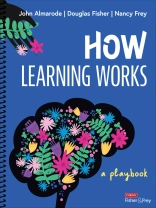Translate the science of learning into strategies for maximum learning impact in your classroom.
The content, skills, and understandings students need to learn today are as diverse, complex, and multidimensional as the students in our classrooms. How can educators best create the learning experiences students need to truly learn?
How Learning Works: A Playbook unpacks the science of how students learn and translates that knowledge into promising principles or practices that can be implemented in the classroom or utilized by students on their own learning journey. Designed to help educators create learning experiences that better align with how learning works, each module in this playbook is grounded in research and features prompts, tools, practice exercises, and discussion strategies that help teachers to
- Describe what is meant by learning in the local context of your classroom, including identifying any barriers to learning.
- Adapt promising principles and practices to meet the specific needs of your students—particularly regarding motivation, attention, encoding, retrieval and practice, cognitive load and memory, productive struggle, and feedback.
- Translate research on learning into learning strategies that accelerate learning and build students’ capacity to take ownership of their own learning—such as summarizing, spaced practice, interleaved practice, elaborate interrogation, and transfer strategies.
- Generate and gather evidence of impact by engaging students in reciprocal teaching and effective feedback on learning.
قائمة المحتويات
Acknowledgments
INTRODUCTION
The Purpose of This Learning Playbook
The Learning Plan With the Modules
Learning Within the Modules
Collaborating for Great Learning
PART I
CHAPTER 1. WHAT DOES LEARNING LOOK LIKE IN YOUR CLASSROOM?
A Definition of Learning
Checks for Understanding
CHAPTER 2. WHAT ARE DIFFERENT WAYS TO THINK ABOUT LEARNING?
Three Different Types of Knowledge
Three Parts of the Learning Process
Checks for Understanding
CHAPTER 3. WHAT ARE THE BARRIERS TO LEARNING?
Acquisition
Consolidation
Storage
Challenges to Learning by Design
Checks for Understanding
CHAPTER 4. HOW DO STUDENTS LEARN?
Learning Myths
The Science of Learning
Checks for Understanding
PART II
CHAPTER 5. PROMISING PRINCIPLE 1: MOTIVATION
What Is Motivation?
What Does This Principle or Practice Look Like in the Classroom?
How Do We Implement This Principle and Practice Into Our Classrooms?
Checks for Understanding
CHAPTER 6. PROMISING PRINCIPLE 2: ATTENTION
What Is Attention?
Factors Influencing Attention
What Does This Principle or Practice Look Like in the Classroom?
How Do We Implement This Principle and Practice Into Our Classrooms?
Checks for Understanding
CHAPTER 7. PROMISING PRINCIPLE 3: ELABORATE ENCODING
What Is Elaborate Encoding?
Components of Elaborate Encoding
Approaches to Promoting Elaborate Encoding
What Does This Principle or Practice Look Like in the Classroom?
How Do We Implement This Principle and Practice Into Our Classrooms?
Checks for Understanding
CHAPTER 8. PROMISING PRINCIPLE 4: RETRIEVAL AND PRACTICE
What Is Retrieval and Practice?
Timing of Retrieval
Types of Retrieval Practice
What Does This Principle or Practice Look Like in the Classroom?
How Do We Implement This Principle and Practice Into Our Classrooms?
Checks for Understanding
CHAPTER 9. PROMISING PRINCIPLE 5: COGNITIVE LOAD
What Is Cognitive Load?
What Does This Principle or Practice Look Like in the Classroom?
How Do We Implement This Principle and Practice Into Our Classrooms?
Checks for Understanding
CHAPTER 10. PROMISING PRINCIPLE 6: PRODUCTIVE STRUGGLE
What Is Productive Struggle?
What Does This Principle or Practice Look Like in the Classroom?
How Do We Implement This Principle and Practice Into Our Classrooms?
Checks for Understanding
CHAPTER 11. PROMISING PRINCIPLE 7: FEEDBACK
What Is Feedback and What Makes It Effective?
What Does This Principle or Practice Look Like in the Classroom?
How Do We Implement This Principle and Practice Into Our Classrooms?
Checks for Understanding
Where to Next?
PART III
CHAPTER 12. EXPLICIT STRATEGY INSTRUCTION
The Gradual Release of Responsibility
Effective Learning Practices
A Return to Germane Cognitive Load
Checks for Understanding
CHAPTER 13. LEARNING STRATEGY 1: GOAL SETTING
The Benefits of Goal Setting
Getting Ready for Goal Setting
The Process of Goal Setting
Checks for Understanding
CHAPTER 14. LEARNING STRATEGY 2: INTEGRATING PRIOR KNOWLEDGE
The Benefits of Integrating Prior Knowledge
Getting Ready to Integrate Prior Knowledge
A Process for Integrating Prior Knowledge
Bonus Material: Annotated Reading
Checks for Understanding
CHAPTER 15. LEARNING STRATEGY 3: SUMMARIZING
Essential Characteristics of Summarizing
Getting Ready to Summarize
A Process for the Explicit Instruction of Summarizing
Checks for Understanding
CHAPTER 16. LEARNING STRATEGY 4: MAPPING
Three Different Ways to Map
Getting Ready for Mapping
A Process for the Explicit Instruction of Summarizing
Checks for Understanding
CHAPTER 17. LEARNING STRATEGY 5: SELF-TESTING
Benefits of Self-Testing
What if Learners Make Mistakes?
Getting Ready to Implement Self-Testing
A Process for Implementing Self-Testing
Bonus Material: Cooperative Learning
Checks for Understanding
CHAPTER 18. LEARNING STRATEGY 6: ELABORATIVE INTERROGATION
Benefits of Elaborative Interrogation
Getting Ready to Implement Elaborative Interrogation
Bonus Material: Jigsaw
A Process for Implementing Elaborative Interrogation
Checks for Understanding
PART IV
CHAPTER 19. GENERATING AND GATHERING EVIDENCE
Planning for Evaluation
Success Criteria and Evaluation
Planning to Gather Evidence
Planning to Collect and Organize Evidence
Making Sense of the Evidence
Conclusion
References
Index
About the Authors
عن المؤلف
Nancy Frey is a Professor in Educational Leadership at San Diego State and a teacher leader at Health Sciences High and Middle College. She is a credentialed special educator, reading specialist, and administrator in California. She is a member of the International Literacy Association’s Literacy Research Panel. Her published titles include The Illustrated Guide to Visible Learning, Welcome to Teaching Multilingual Learners, Teaching Foundational Skills to Adolescent Readers, and RIGOR Unveiled: A Video-Enhanced Flipbook to Promote Teacher Expertise in Relationship Building, Instruction, Goals, Organization, and Relevance.












